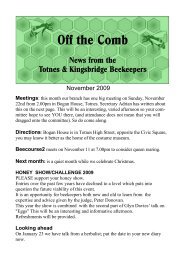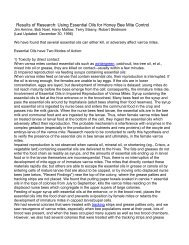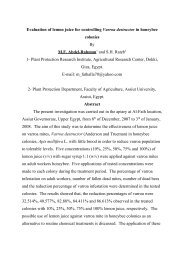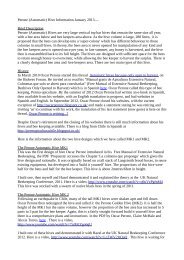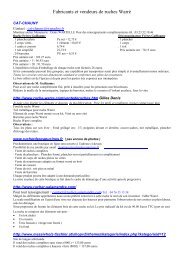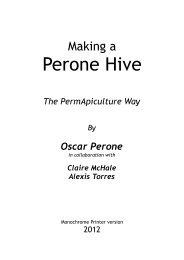THE MODERN TOP BAR HIVE - BioBees
THE MODERN TOP BAR HIVE - BioBees
THE MODERN TOP BAR HIVE - BioBees
Create successful ePaper yourself
Turn your PDF publications into a flip-book with our unique Google optimized e-Paper software.
tries to silence this revolt by applying liberal doses of smoke, which, as often as<br />
not, aggravates the bees rather than subduing them, with painful and disruptive<br />
consequences.<br />
• Frames are made to precise dimensions, which means that they must be<br />
purchased - at no small cost - from manufacturers equipped with expensive,<br />
precision machinery and laboriously assembled with hammer and pins. They are<br />
easily damaged by rough handling and are difficult to clean thoroughly.<br />
• Foundation wax also has to be bought in - as precision mills cost a king's ransom<br />
– and fitted carefully into the frames with more pins and wire.<br />
• The wax used for making foundation will contain a random mix of all the lipophilic<br />
substances that previous beekeepers have chosen to apply, as it is bought in by<br />
the millers from whoever cares to sell it to them. This may include sources that<br />
are less than scrupulous about the chemicals and medications they use.<br />
• Then, when it comes to harvest time, we have the problem of weight. A full super<br />
of honey can weigh between thirty and sixty pounds, depending on the type of hive<br />
and number of frames. Not surprisingly, hernias and chronic back pain are<br />
commonplace among commercial beekeepers and many people, especially women,<br />
are put off even hobby-scale beekeeping by this consideration alone.<br />
Top bar beekeeping is about as simple as beekeeping can get, while maintaining<br />
provision for occasional inspections, comfortable over-wintering and non-destructive<br />
harvesting. Everything you need is in one box – the beehive – which you can make<br />
yourself.<br />
Top bar beekeeping can produce plenty of honey, but the emphasis here is on<br />
sustainability and keeping healthy bees rather than setting records for honey crops,<br />
which inevitably has a cost to the welfare of the bees. The essence of sustainability is to<br />
work well within the limits of a natural system: pushing any living thing beyond its<br />
natural capacity can only lead to trouble.<br />
In my book, The Barefoot Beekeeper, I describe the top bar hive and its management and<br />
discuss the philosophy of natural beekeeping, in which we aim to work with the natural<br />
impulses and habits of the bees, respecting the integrity of the brood chamber, leaving<br />
them ample honey stores over winter and generally arranging things in order to cause<br />
their bees as little stress and disturbance as possible.<br />
I hope soon to be able to welcome you to our Natural Beekeeping Forum, which has<br />
members from around the world who have chosen this most fascinating way to provide<br />
homes for honeybees and have a sustainable crop of honey.<br />
Philip Chandler<br />
Free DIY plans for building a top bar hive are available from the author's web site at<br />
www.biobees.com The Barefoot Beekeeper is also available from this site, as well as from<br />
Amazon or any bookseller using the ISBN 978-1-4092-7114-7.<br />
The Natural Beekeeping Network discussion forum is at www.naturalbeekeeping.org<br />
Friends of the Bees is a charity founded to conserve and protect bees and to research<br />
and promote more natural beekeeping methods. We aim to work with others to help<br />
restore the natural balance between honeybees and other insect pollinators. See<br />
www.friendsofthebees.org for more information.





